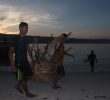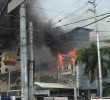Background and main causes of displacement
The Philippines is one of the most natural-disaster-prone countries in the world, with hundreds of thousands of people displaced each year due to floods, storms, earthquakes or volcanoes. Development projects such as mines, roads or hydro-electrical dams are also major causes of displacement in the country, mainly affecting the poor and indigenous populations. At the end of 2006, the Philippines was designated by the Geneva-based Centre on Housing Rights and Eviction (COHRE) as one of the top three countries violating housing rights, with hundreds of thousands of people displaced because of development or �beautification� projects (COHRE, 5 December 2006).
As regards, conflict-induced displacement, the focus of this overview, armed incidents between government forces and rebel groups, and in particular those involving government forces and the communist rebels of the New People�s Army (NPA), sporadically affect all regions of the country. But heavy fighting and large-scale displacement is mainly concentrated in the southern island of Mindanao where Muslim separatist rebels have fought government forces since the 1970s. The conflict in Mindanao is rooted in the general underdevelopment of the region, the unequal distribution of wealth, and the lack of sufficient effort by the central government to integrate the Muslim (or “Moro”) minority into the political and institutional fabric of the overwhelmingly Roman Catholic country. Central to the conflict are also conflicting claims over land between, on the one hand, Muslims and indigenous people who held their land on communal ownership basis and, on the other, the government who imposed the Regalian doctrine of property ownership, which did not recognise ancestral land claim or ownership. As a consequence, many Muslims and indigenous people were deprived of their land largely to the benefit of Christian settlers. The fighting and displacement is mainly concentrated in the Muslim-populated areas of central and south-western Mindanao, where rich reserves of untapped natural resources and raw materials have been an added factor in the government’s fight against Muslim secessionist movements. Other causes of insecurity in Mindanao include armed incidents between government forces and the communist rebels of the NPA, widespread banditry and clan disputes (or �rido�), which sometimes degenerate into wider armed incidents involving armed militias, the military and Muslim armed groups.
In 1996, a peace agreement between the government and the rebel Moro National Liberation Front (MNLF) � the first Moro armed separatist group � was signed, allowing for the implementation of the 1976 Tripoli Agreement; this established some degree of autonomy in 13 provinces and nine cities in the southern Philippines. The agreement was, however, rejected by the Moro Islamic Liberation Front (MILF), a splinter group from the MNLF established in 1984 with a more religious agenda (USIP, 31 January 2005, p.5). The MILF, nevertheless, agreed to open discussions with the government and a ceasefire agreement was signed in 1997. It was, however, repeatedly violated in the following years.
Between 2000 and 2006, armed conflict in the Philippines caused the displacement of nearly two million people. The majority were displaced in Mindanao by two major military operations launched by the government in 2000 and 2003. A ceasefire agreed in July 2003 put an end to the fighting and allowed for the return of most of the displaced, despite conditions that were often not conducive to sustainable reintegration. Since then, improved dialogue and confidence-building measures established between the government and the MILF have prevented sporadic armed skirmishes and army operations against criminal gangs from turning into larger armed confrontations. Also, a Malaysian-led international monitoring team has been deployed in Mindanao since October 2004 and has helped to maintain the ceasefire.
Despite a third year in a row without a major armed confrontation between the government and the MILF, continued tension and intermittent armed clashes have during 2006 continued to displace tens of thousands of people, further delaying the signing of a final peace agreement. The main bone of contention continues to be the issue of ancestral domain, or the territorial coverage of the future Moro homeland. While armed encounters between the government and the MILF have been decreasing since 2003, those with the communist rebels of the NPA have been on the increase, in particular during 2005 and 2006 when President Gloria Arroyo declared an �all-out war� against the NPA. Peace talks between the communist insurgents and the government have stalled since August 2004 and look unlikely to resume anytime soon.










